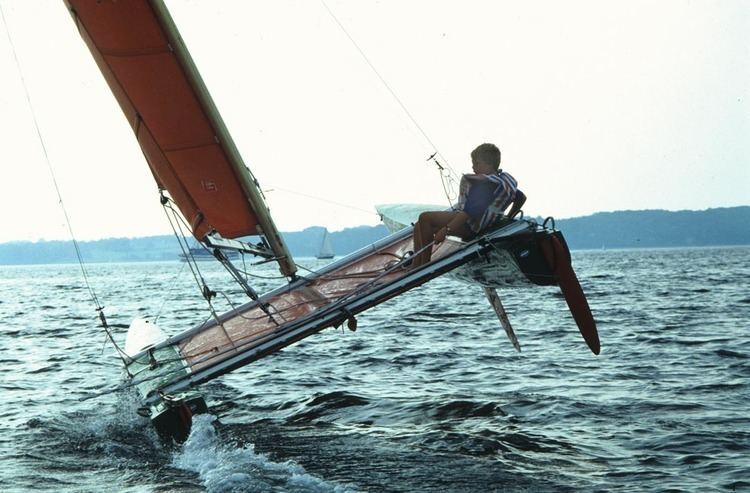 | ||
The International B-class/F20 Catamaran, is a development class, on the comeback after the fracturing of the original B-class, into the myriad of one design, off the beach cats we have today.
Contents
Background
The B-class was founded during the 1960s and was part of the 4-tier IYRU (now ISAF) approach to divide up the sports catamaran sailing scene into 4 separate groups. These A, B, C and D classes were governed by a very small set of class rules to which each design had to comply. In the beginning it was just:
All boats designed and built to these specs would be grouped into one fleet and race each other for crossing the finish line first. The A-Class is the largest remaining of those 4 main classes, while the recent development in wing sail technology, the C-Class is enjoying a revival.
In 1967, the then International Yacht Racing Union (IYRU, now ISAF) decided to run a week long series of trials (August 5–12) to determine the best "A" and "B" classes of catamaran design to be selected for International status. The trials were held at the Catamaran Yacht Club, Isle of Sheppey (a small island in the Thames Estuary, 50 miles to the east of London), Kent, UK. The B Class was easily won by a Tornado sailed by Reg White and Bob Fisher, who took six first places out of nine races. The Tornado went on to be used for the Olympics from 1976 onwards. Nearly 50 years later, the Tornado is still one of the highest performing B Class catamarans.
Unfortunately the choice of such a beamy and thus difficult to trailer boat, left a massive hole in the market. Consequently the B-Class quickly splintered into a score of sub classes like the one-design Hobie 16's, Nacra 5.8, and more recently the Formula 16 and Formula 18 specifications with strict class rules.
Specifications
The rigid specification of the Tornado combined with splintering mentioned above, has meant there has been a virtual absence of a B-class specification for many years.
However the recent arrival of what are being called International F20 catamarans we are starting to see a revival of a class that could lead sailors into the future of high tech, fully foiling and affordable catamaran sailing.
The current trend is to create a box rule like the A-Class but relax the rules that are preventing it from becoming fully foiling. Public opinion is leaning towards avoiding the pitfalls of the Formula 16's and Formula 18's that excluded several existing designs, such that the new spec would include all existing sub-20 ft off the beach catamarans. These dimensions are stretched out to accommodate the three production fully foiling Formula 20's: the Nacra F20 FCS, the Flying Phantom and the Marstrom M-20
Subsequently the International F20 catamarans is defined by
Practical considerations:
